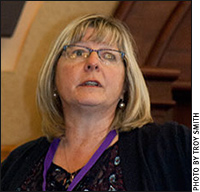ISBCW 2016:
Feedlot Lameness
Study sheds light on lameness prevalence and mitigation strategies.
by Kasey Brown, senior associate editor
MANHATTAN, Kan. (June 10, 2016) — Lameness, a leg or foot problem that modifies an animal’s gait, is a big deal in the cattle industry. However, we know very little about it, noted Karen Schwartzkopf-Genswein, researcher at the Lethbridge Research and Development Centre for Agriculture and Agri-Food Canada. She shared results of her study looking at the occurrence, characterization and risk factors associated with lameness within Alberta feedlots with more than 100 attendees of the fifth International Symposium on Beef Cattle Welfare (ISBCW) in Manhattan, Kan., June 8-10.

The incidence of lameness was 5.89% per year compared to 9.44% for respiratory disease, so lameness is indeed a big deal, says Karen Schwartzkopf-Genswein.
Part of the study included a health records study of 29 feedlots and 111,015 cattle over a five-year period. The other part included a live-animal study that evaluated more than 10,000 head in two feedlots weekly during a two-year period.
Cattle were assigned a lameness severity score on a scale of 1 to 5 after evaluating their gait. Physiological measurements were also taken, including substance P, immune function indicators, cortisol levels, body temperature and inflammation noted. Pen conditions were scored and tag scores (levels of dirt on the hide) were noted.
The incidence of lameness was 5.89% per year compared to 9.44% for respiratory disease, so lameness is indeed a big deal. Schwartzkopf-Genswein said lameness represented 30.38% of all treated animals per year, and relapse rates were 8.07%. Lameness caused 7.76% of euthanized cattle.
Treatment costs varied between $8.40 and $42.20. With each additional pull, the cost increased by $3.50. Overall, she reported, production loss was estimated at $81.40 per animal.
The two largest types of lameness were foot rot at 45.7%, followed by digital dermatitis at 23.2%. Others included swollen joints or joint infections, injury, laminitis, P3 necrosis, lame but no swelling, and problems with the proximal limb.
Schwartzkopf-Genswein admitted that the cowboy diagnosis at the time of pull and the diagnosis of the research staff only matched 33%, which shows that by improving lameness diagnosis, welfare can be improved and antibiotic use can be reduced. To improve diagnosis, you must examine the feet and claws, she asserted.
Rough handling, muddy pen condition, type of cattle, pen density and diet all contribute to lameness. She said lameness decreases 1.5% for every 3.3 feet (1 meter) of bunk space, and lameness decreases 0.8% for every 1% increase in forage.
Lameness is incredibly important to welfare and economics. Schwartzkopf-Genswein said future plans include designing a decision tree to improve mitigation strategies.
Watch for additional coverage of the 2016 ISBCW on www.angus.media and in the Angus Journal and Angus Beef Bulletin. Comprehensive meeting coverage will be archived at www.api-virtuallibrary.com/meetings_other_news.html.
Editor’s Note: The articles used within this site represent a mixture of copyrights. If you would like to reprint or repost an article, you must first request permission of Angus Media by contacting the editor at 816-383-5200; 3201 Frederick Ave., Saint Joseph, MO 64506. API claims copyright to this web site as presented. We welcome educational venues and cattlemen to link to this site as a service to their audience.
